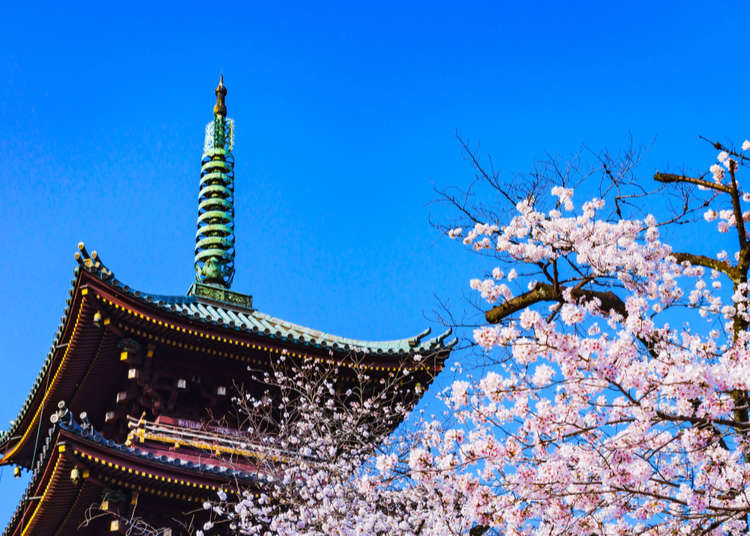
Spring Travel Guide: 10 Tips for Visiting Japan in Spring
- Written by: David McElhinney
Many Japanese people regard spring as their favorite season, and with good reason! The temperate climate emerges from its wintery hibernation, providing arguably the best time to visit Japan all year round.
Combine this with an eclectic seasonal cuisine including a menagerie of fresh fruits and vegetables, a renewed energy to the festival and event season, and, of course, the week-long appearance of the synonymous Japanese cherry blossoms, and it's easy to see why this is such a special time of year.
When it comes to organizing your trip to Japan in spring, there are many things you'll need to bear in mind. So here are 10 insider tips to help you along the way!
- Table of Contents
-
- 1. Spring Weather in Japan: Know before you go!
- 2. Know what to pack for Japan in spring
- 3. Book (and confirm) your accommodations well in advance
- 4. Visit (or avoid) these popular spots in spring
- 5. Day + Night-time Cherry Blossom viewing
- 6. Not only cherry blossoms: check out what else is in bloom
- 7. Make sure you sample the spring cuisine
- 8. The Spring calendar is chock-full of festivals!
- 9. Not too late to experience an onsen!
- 10. Have allergies? Prepare for Hay Fever Season!
- Japan Hayfever/Pollen Forecast
1. Spring Weather in Japan: Know before you go!
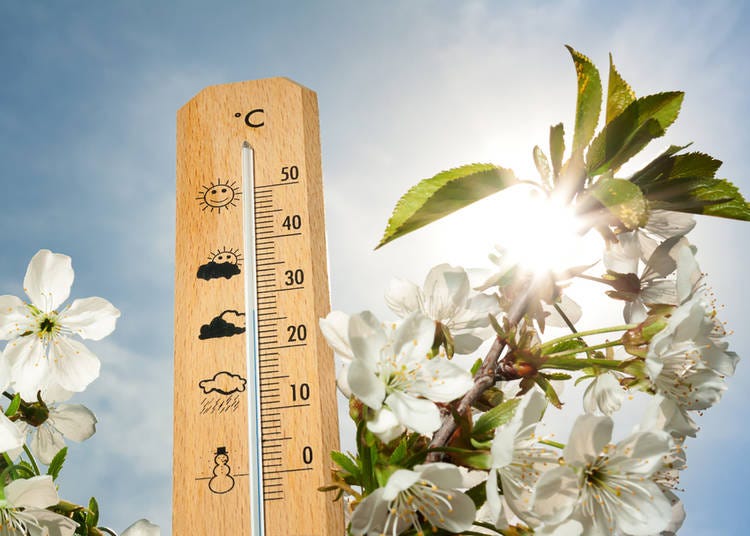
Spring in Japan means awesome weather. The winters can be laden with a frigid, icy bite. The summers can toss up rip-roaring heatwaves. Autumn is somewhat erratic (and not unaccustomed to a typhoon or two), yet spring is typically beautiful.
More often than not, a spring day is accompanied by temperate air, sunny skies, maybe a calm breeze, and slightly longer hours of daylight than the winter which has just passed. The following table details what you can expect in some of the country's tourist hotspots.
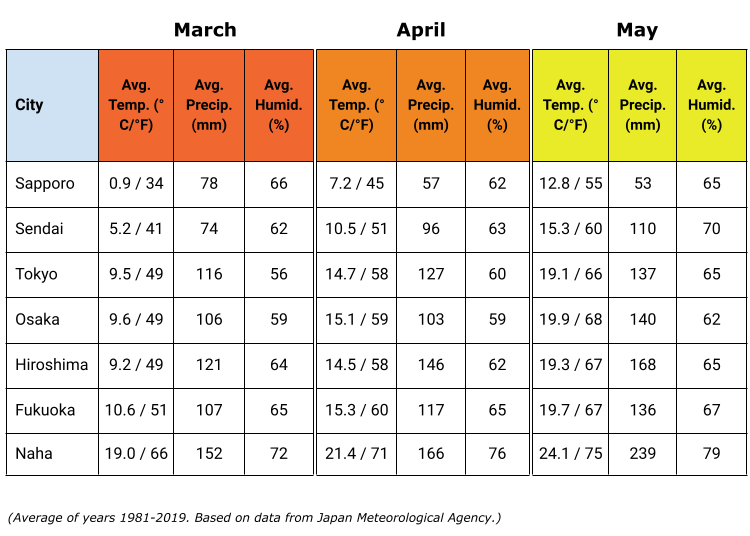
2. Know what to pack for Japan in spring

It's hardly a newsflash but knowing what to pack is pretty important. You can generally pack quite light for a trip to Japan in spring, but here are a few tips on avoiding some potential pitfalls.
The later in spring you come to Japan, the less likely you are to need warm clothes. However we suggest bringing at least a couple of pairs of pants, at least one jumper and a coat for the evenings—of course, this is commensurate with your dates of travel and where you plan to visit. As you can see from the table above, rain is not entirely uncommon, so that a light waterproof option may be worthwhile too.
Miscellaneous items that you should consider bringing include a decent camera for the cherry blossoms if you’ve got one, sunscreen if you're of a pasty complexion, and hay fever tablets if you're a frequent sufferer (more on that later).
Of course, if you want to go skiing in Hokkaido or hiking, then appropriate clothing and footwear are a given!
3. Book (and confirm) your accommodations well in advance

Given that spring is such a popular time for the Japanese tourism industry we advise that you organize your accommodation well in advance.
Popular hotels, hostels, ryokan and even Airbnb options are all likely to book up fast so it's best to be ahead of the curve in that regard! If you are booking an Airbnb or similar arrangement, be sure to confirm the booking well in advance – “just in case”. This way you have time to make alternative arrangements if something falls through.
4. Visit (or avoid) these popular spots in spring
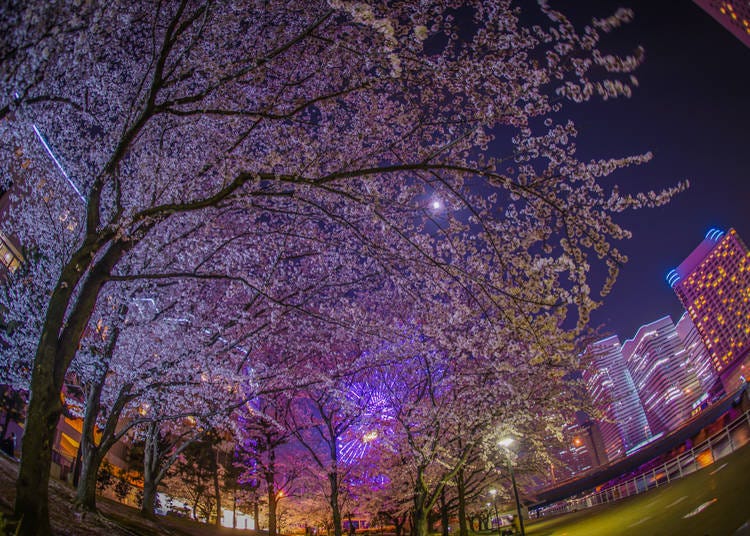
The Japanese cherry blossom season is a truly special phenomenon. There may be no other type of flora that draws tourists in the same way that these elegant trees do.
The bottom line is this, cherry blossom season lasts for around 2 weeks and only comes about once a year (typically towards the end of March). So, if you want to catch a glimpse of this natural wonder, please be aware that it will be busy.
The only way to really get around this is by heading to the less densely populated areas of Japan—the mountains of northern Honshu have some great cherry blossom scenery—although if your time is limited, this may not be possible.
On the other hand, if wading through the camera-wielding hordes of people doesn’t bother you too much, then here are some of our top recommendations!
Tokyo – Shinjuku Gyoen, Ueno Park, and the Meguro River have some of the best cherry blossom groves to be found in the capital. Although just wandering around Tokyo, you will see more than your fair share as well.
Kyoto – Kyoto is awash in sakura flowers when the cherry blossom season hits, simply by walking around the city, you'll encounter many beautiful sights. Murayama Park is synonymous with the cherry blossom in Kyoto social circles and is usually as breath-taking as it is crowded. The aptly named Path of Philosophy is a popular sakura-lined walkway in Kyoto which is particularly special to amble down in the early evening.
Nara – Nara is famous as the city which has integrated the local deer into its society. If you've ever wanted to bask in the glory of the Japanese cherry blossoms while in the company of a poised sika deer, then Nara Koen (park) is the place to do it.
Alternatively, check out our guide to hidden cherry blossom spots in Japan!
5. Day + Night-time Cherry Blossom viewing
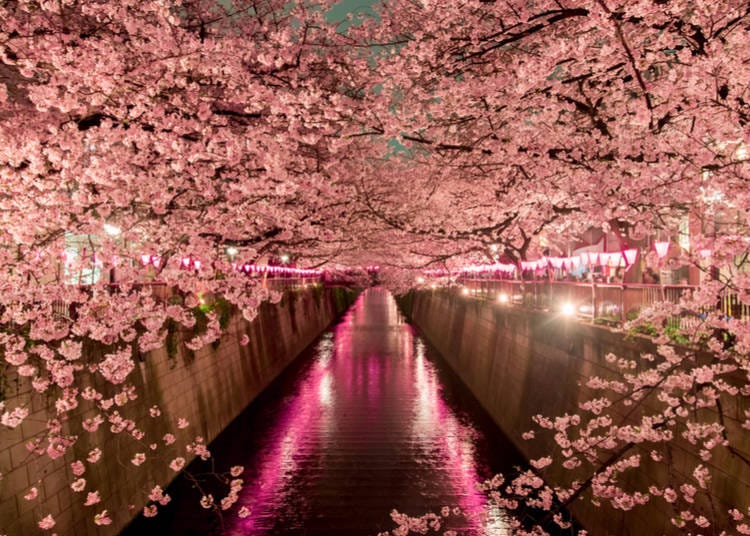
Cherry blossoms come into bloom around the end of March and will linger through the first week or two of April. This can vary depending on a variety of meteorological factors; How harsh was the winter? What are the seasonal wind speeds like? Are there extraordinary levels of precipitation? Where in Japan are the blossoms located? The general rule of thumb is the further south you are, the earlier they will appear!
Be sure to check the cherry blossom forecast below to help you plan (please note that this is the prospective flowering date, the full bloom will be around a week later).
6. Not only cherry blossoms: check out what else is in bloom
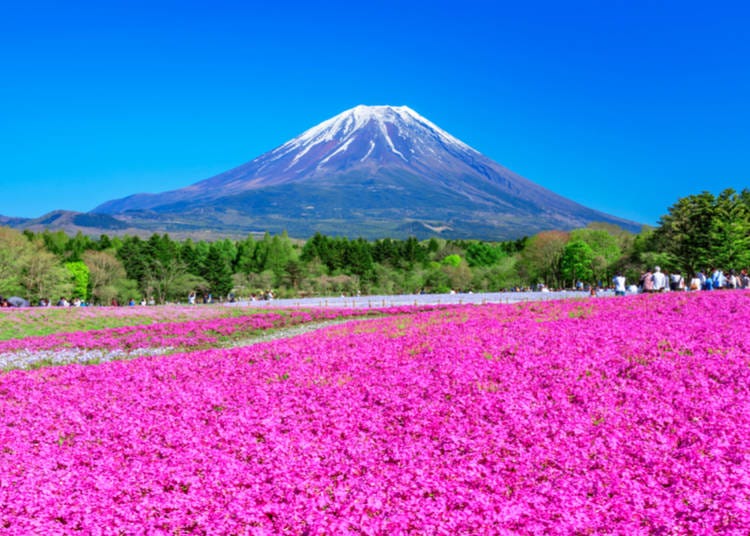
Cherry blossoms are undoubtedly awe-inspiring but they aren't the only species of flower that are worth seeing in Japan in spring.
Blue nemophila, purple violets, vibrant pink phlox, apricot-colored camelia, plum blossoms, and pale wisteria weeping blossoms will all join in on the floral party too. There are many popular viewing spots located in and around Tokyo as well as in Hokkaido in the north.
7. Make sure you sample the spring cuisine
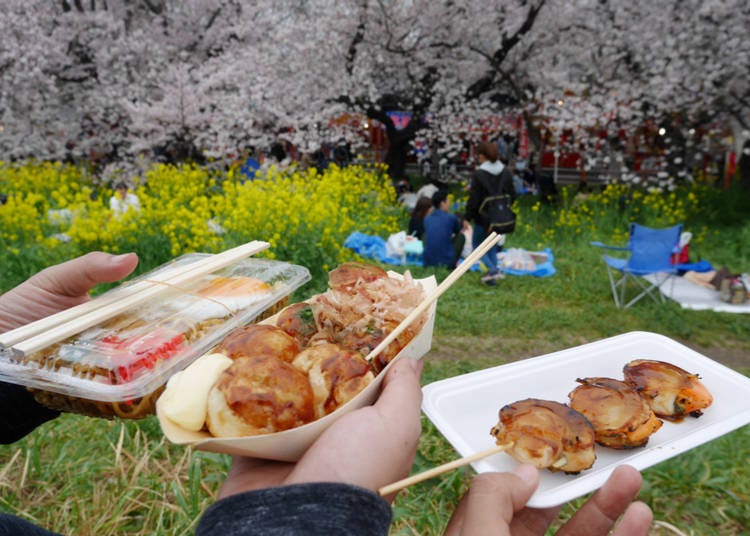
Strawberries: Strawberries are known as the queen of Japanese fruits and are a must-eat food in the Japanese spring. They come in a variety of shapes, sizes, and even colors! Japanese strawberries come in every shade along the red color spectrum, from a creamy pinkish-white to varieties that are deep shades of rose.
Bamboo shoots: Bamboo shoots are a super popular ramen topping and often appear on izakaya menus as a side or sharing dish (sometimes under the name "menma"). They are particularly delectable this time of year, so be sure to give them a try.
Shellfish: Mussels, clams, and various other shellfish are trawled in from the Pacific en masse every spring. Whether you eat them raw as sushi or cooked into a nabe hotpot, your taste buds will no doubt be satisfied.
Plus, seasonal cuisine isn’t limited to foods, but drinks as well! Major international chains such as Starbucks and McDonald’s will get into the spring spirit as well with sakura-flavored lattes, teas, and milkshakes.
You'll also find heaps of street food at local festivals - keep your eyes peeled!
8. The Spring calendar is chock-full of festivals!
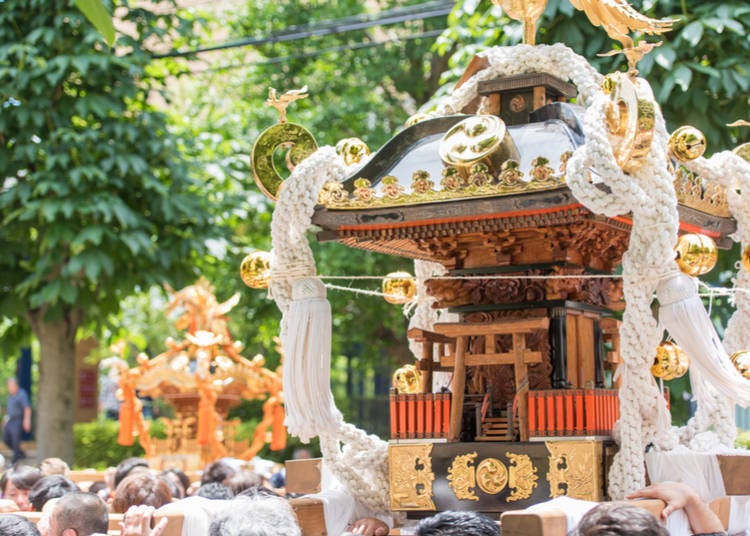
Here are the top festivals in and around Tokyo and Hokkaido this spring:
Kanamara Matsuri (Early April) – Simply put, this is a festival dedicated to the phallus! It's as eccentric as it sounds with a giant model of the male genitalia forming the centerpiece of this parade which takes place on the streets of Kawasaki.
Kanda Matsuri (Mid-May) – One of the most famous festivals in Tokyo all year round. Over 200 mikoshi (portable shrine floats) will be paraded around the downtown area close to Kanda Shrine paying homage to the legendary Tokugawa Shogun that ruled Japan for over 200 years. Note that this is not held every year.
Sanja Matsuri (Mid-May) – One of the three great Shinto celebrations in Tokyo, held at the city's oldest temple, Senso-ji, in Asakusa. The parade will involve a procession of priests, acolytes, city officials, geisha, musicians, and over 100 mikoshi.
Earth Day (Late April) – This is an eco-friendly festival in Tokyo's Yoyogi Park which pays homage to the humble planet that wee earthlings call home.
Hokkaido – There are a variety of flower festivals spread across Japan's largest northern landmass through the months of spring. They celebrate the picturesque nature for which the island is so acclaimed—sakura, <@pink moss phlox|a=@>, azaleas and more!
9. Not too late to experience an onsen!
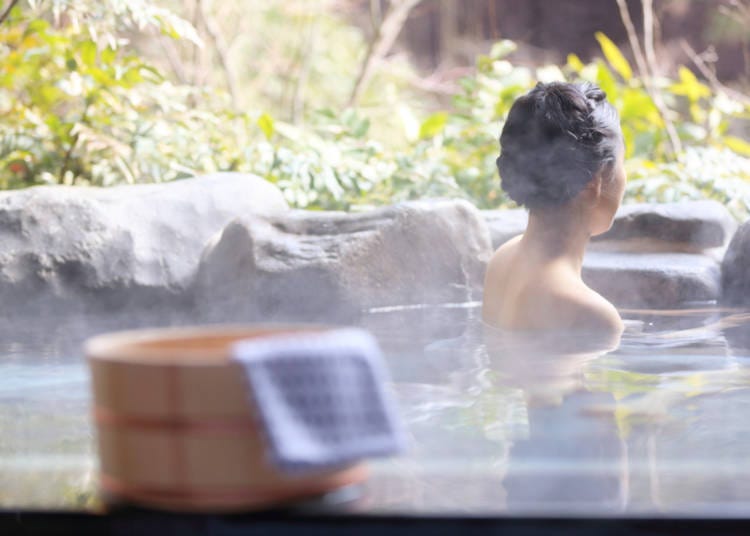
As you can probably guess, the typical season for soaking in a steamy bath of geothermal water (onsen) is during the winter. However, as alluded to earlier, the further north you are, the later the temperate spring will set in. So if you find yourself in the likes of Gunma, Niigata, the Tohoku region or Hokkaido, make sure you make time to take a dip in a Japanese onsen bath!
10. Have allergies? Prepare for Hay Fever Season!
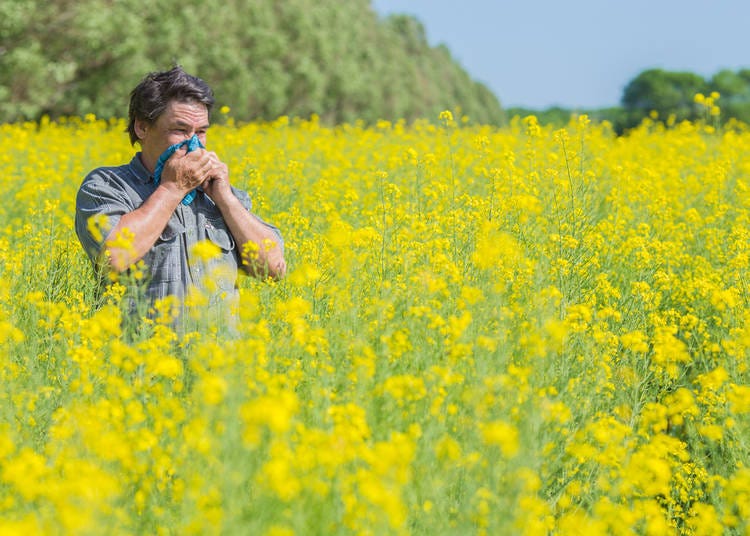
While the spring welcomes a deluge of beautiful flora to the streets and parks of Japan it’s accompanied by a skyrocketing pollen count so if you’re a sufferer of hay fever you ought to be prepared. (Also note that in Japan it’s not just “generic” pollen, but rather specific species that dust the streets.)
Japan Hayfever/Pollen Forecast

So how can you prevent a pollen-induced sneezing fit or ward off those dreaded itchy eyes? Antihistamines are typically the most reliable hay fever meds (just ensure you don't get the drowsy kind!) and can usually be bought over the counter. If you're more of a chronic sufferer of hay fever, then consider consulting with your doctor.
Given that many people in Japan have this mild allergy, it is relatively easy to get eye drops and face masks (which are sold in every convenience store in the country). Although if you want to circumvent the language barrier, then maybe consider packing some from home—just to be sure.
David is a Northern Irish freelance writer living in Tokyo. He loves living in Japan, reading about Japan, writing about Japan and eating Japanese food. He also spends a lot of time exercising, playing rugby and risking a litany of muscle-related injuries in yoga class.
- Category
*Prices and options mentioned are subject to change.
*Unless stated otherwise, all prices include tax.
Popular Tours & Activitiess
Recommended places for you
-

Jukuseiniku-to Namamottsuarera Nikubaru Italian Nikutaria Sannomiya
Izakaya
Kobe, Sannomiya, Kitano
-

Kanzenkoshitsuyakinikutabehodai Gyugyu Paradise Sannomiya
Yakiniku
Kobe, Sannomiya, Kitano
-
Appealing

Rukku and Uohei
Izakaya
Sapporo / Chitose
-

ISHIDAYA Hanare
Yakiniku
Kobe, Sannomiya, Kitano
-

Kambei Sannomiyahonten
Yakiniku
Kobe, Sannomiya, Kitano
-
Goods

Yoshida Gennojo-Roho Kyoto Buddhist Altars
Gift Shops
Nijo Castle, Kyoto Imperial Palace
-

A Travel Game Changer! Go Hands-Free Between Tokyo and Kyoto with LUGGAGE EXPRESS by JTB and JR Tokai
by: Guest Contributor
-

Keisei × Keikyu 16-Temple Goshuin Tour: Discover Deeper Tokyo & Yokohama
by: Guest Contributor
-

The Best Japanese Food Representing 2025! 'Dish of the Year®' Annual Award Results Announced
-

Simply Oishii Wagashi School Discover Japanese Culture Through Wagashi: A Hands-On Experience!
by: Guest Contributor
-

[Extended Offer!](12% OFF KKday Coupon) Mt. Fuji Autumn Leaves, Powder Snow & More! 15 Best Tours to Experience Japan in Fall & Winter
-
Ad

Preserving the Beauty of World Heritage Site Shirakawa-go for the Future Through Responsible Travel
-

Visiting Hokkaido in Spring (March/April/May): Weather, Things to Do & What to Wear
-

Kesennuma City Memorial Museum (Ruins of Koyo High School): Telling the Story of the 3/11 Great East Japan Earthquake
-

Locals Recommend: 10 Favorite Places for Cherry Blossoms in Osaka
-

10 Dreamy Places to See Cherry Blossoms in Fukushima Prefecture in 2025
by: Alexander Litz
-

6 Fun Things to Do at Tokyo's World-Famous Tsukiji Outer Market!
-

Tokyo Cherry Blossom Festival Season in Photos! (2019)
- #best sushi japan
- #what to do in odaiba
- #what to bring to japan
- #new years in tokyo
- #best ramen japan
- #what to buy in ameyoko
- #japanese nail trends
- #things to do japan
- #onsen tattoo friendly tokyo
- #daiso
- #best coffee japan
- #best japanese soft drinks
- #best yakiniku japan
- #japanese fashion culture
- #japanese convenience store snacks













